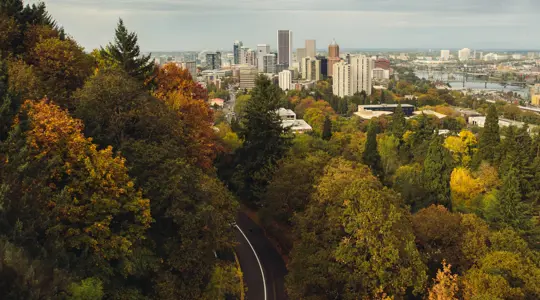Portland: where mass timber meets mass market
Attracted to the outdoor culture of the United States’ Pacific Northwest, progressive technology giants and ‘athleisure’ firms have embraced different construction methods including the use of mass timber as a more sustainable building material for their facilities. Such backing is helping to position Portland, Oregon as an international hub for mass timber design, construction and thought leadership.
With corporate giants, Microsoft and Amazon headquartered in Seattle and Google and Facebook having a significant presence, the region within which Portland sits and draws talent from, is synonymous with innovation and early adoption.
This culture of reinvention and change is reinforced by tech start-ups setting up shop in Portland, a more affordable prospect than its neighbours Silicon Valley and Seattle.
Alongside a range of tax incentives making real estate even more affordable, this translates to such companies having more to spend on crafting a built environment that will inspire their workforces and enhance creativity.
Mass timber moves from niche to mainstream
Climate change brings with it an increased focus on sustainability in construction, both for architects and end users. In the commercial real estate market, this focus has become ultra-competitive, thanks to 2020’s enforced shift to home working, meaning anything that offers up the prospect of keeping rental yields buoyant – is not to be ignored.
Consequently, in Portland and elsewhere across the United States, mass timber building projects are set to move from niche to mainstream territory, assisted by imminent ratification in 2021 of the International Building Code (IBC), which will act to control the material’s use in structures up to 18 storeys high and nearly one million square feet in area.
Beyond allowable building size, the code governs fire-resistance ratings, fire safety during construction, as well as new allowances for exposed timber vs wood with non-combustible protection.
This evolution from performance-based to prescriptive design, creating certainty regarding mass timber’s capabilities and therefore instilling confidence in project stakeholders.
The 2021 IBC changes allowing for high rise mass timber are sure to drive demand, since they will increase the types of projects where the material can be used. Although this raises the possibility of supply-side constraints as the likes of multi-family residential and speculative developments become part of the reckoning and will increase demand, this could be a short-lived challenge as new suppliers enter the market to meet the burgeoning need for this renewable material.
Mass timber’s day is dawning
While the use of mass timber at scale in the construction of high-rise buildings is in its infancy across the US, technological advances in fabrication are leading to more affordable and standardised rates. In addition, the incoming Biden/Harris administration has committed the US to re-joining the Paris Climate Agreement.
This means Portland’s mass timber fortunes could receive a further boost in the form of federal incentives and tax breaks to allow it to play its part in helping reduce the nation’s carbon footprint.
Securing the relevant construction permits can be a challenge for developers, although fast-track options exist in Portland. Despite costing more to produce mass timber, the ability to fabricate offsite means it can be installed quickly, positively impacting scheduling. In addition, ready access to the raw material in America’s heavily forested Pacific Northwest serves to keep the supply chain domestic and ensure short delivery times.
Endorsing renewable materials
The codification of mass timber is a watershed moment for this renewable material and serves to prove its doubters wrong, for it evidences fundamental fire-resistant credentials. It further speaks to mass timber’s resilience in the face of seismic activity, to it constituting a significantly lighter material to manage and to being less energy intensive to produce than steel and concrete.
As one of the country’s greenest cities, it is no surprise that Portland is adopting mass timber at a fast rate.
With its abundant access to timber, approved legislation supporting high rise construction and forward-thinking businesses increasingly looking to reduce their carbon footprint through their real estate projects, Portland is in a prime position to lead the way.

